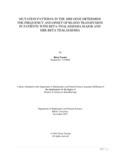Mutation patterns in the HBB gene determine the frequency and onset of blood transfusion in patients with beta-thalassemia major and HbE-beta thalassemia
Abstract
Thalassemia is a blood disorder passed down through families (inherited) in which the body
makes an abnormal form or inadequate amount of hemoglobin. Co-inheritance of beta-thalassemia
alleles from two parents results in beta thalassemia major. Again co-inheritance of a beta-thalassemia
allele from one parent and a structural variant of hemoglobin E from the other parent results in HbE-beta-thalassemia disorder. Patients with HbE/beta-thalassemia represents approximately 50 percent of severely affected beta thalassemia worldwide. Clinical manifestations of HbE-beta thalassemia are highly variable in terms of severity- from thalassemia intermedia like symptoms to severe transfusion-dependent thalassemia major. The reasons for this clinical variability is still poorly understood.
In this study, a total seventeen patients with HbE-beta thalassemia and Beta thalassemia major were included. DNA was isolated from the patients’ blood samples and PCR was performed targeting a 428 bp as the mutational hot spot region of HBB gene. Sanger Nucleotide Sequencing was performed from the purified PCR products. BLAST and HbVar data base were used to identify the mutations of HBB gene responsible for the disease manifestations of the listed patients. Hemoglobin Electrophoresis was also performed to detect and quantify the Hb variants presented in the patients.
Total five types of mutations were identified in the patients of group-1 with HbE-beta thalassemia and beta thalassemia major (early-onset) namely: c.79G>A, IVS-1_5 G>C, c.126_129del_CTTT, c.33 C>A, c.47 G>A and total four types of mutations were found in the patients of group-2 with HbE-beta thalassemia (late-onset) namely: c.9 T>C, c.79 G>A, IVS-1_130 G>C and c.126_129 del_CTTT. Group-1 patients needed blood transfusions from an early age as they had mutation IVS-1_5 G>C (homozygous) or combination of mutations c.79G>A and IVS-1_5 G>C which were highly pathogenic. Group-2 patients needed blood transfusion after 18 years as their mutations were less pathogenic or severe.
The findings from this study will be beneficial for careful tailoring of therapeutic approaches and
management of the complications associated with the treatments of Hb E/beta-thalassemia and beta thalassemia major patients.

